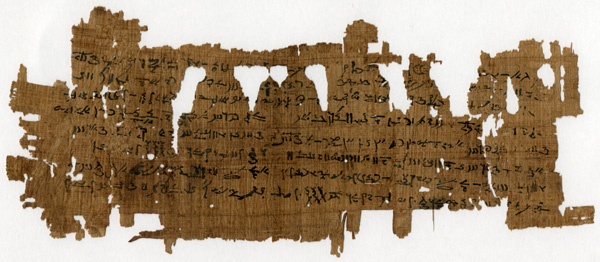Highlights from the Collection:
Nectanebo's Dream or The Prophecy of Petesis
One of the first Egyptian narrative texts to be translated from an ancient manuscript was Nectanebo's Dream, a prophecy concerning the demise of Nectanebo II (359-342 BC), the last native ruler of Egypt. The text is preserved in a Greek translation on a papyrus (P. Leiden I 396) which formed part of the archive of the katochos Ptolemaios and his family. It was discovered at the Serapeum around 1820 and dates to the first half of the second century BC.
'[The manuscript] begins with an elaborate date [which] pertains to the dream of king Nectanebo, a description of which follows. In the dream, the king sees Onuris complain to Isis that the construction of his sanctuary has never been completed although he has always protected the king. The king immediately decides to find out what remains to be done. The priests of Onuris are summoned to the palace and inform the king that everything has been done except for the hieroglyphic inscriptions. The hieroglyph-cutters of all the main temples are then summoned and asked who is most skilled. A man from Aphroditopolis stands up and declares that he will be able to complete the work within a few days. The king receives unanimous confirmation from the other hieroglyph-cutters that this man, whose name is Petesis, son of Hergeus, speaks the truth and that he is indeed the most skilled. Despite these fine recommendations, Petesis decides to postpone his work after he has arrived at Sebennytos. To our regret, the scribe abruptly stopped writing at the most dramatic point in the story when the scene has just been set for a disaster. The last lines state that Petesis had been furnished with a lot of money by the king, that he was a wine-bibber (oinopotês), and that he has caught sight of a most beautiful girl whose very name, Athyrepse, 'Noble Hathor' or 'Hathor is noble', hints at seduction. Among other things, Hathor was, it may be recalled, the goddess of love and drunkenness. Yet Hathor also contains another, less pleasing aspect. She was once sent down to earth by her father, the sun, to destroy mankind. Hence her personality conveys an air of both romance and destruction, and the story evidently exploits this dual nature of the goddess; Petesis is attracted to the girl and the affair eventually leads to his destruction.' From Ryholt, Apokalyptik und Ägypten, edited by Blasius and Schippper (Peeters, 2002), pp. 230-231.
In 1997 it was discovered that the Papyrus Carlsberg Collection included not just a fragment in Egyptian from the very beginning of Nectanebo's Dream (P. Carlsberg 562), which run parallel to the Greek version, but also three excerpts from the beginning of a later sequel to this prophecy (P. Carlsberg 424, 499, and 559). The sequel narrates what happened after Petesis had gone to Sebennytos and had suffered some unfortunate experience there. He apparently delivered a prophecy about foreign invasion and was afterwards consumed by fire. The king is troubled by these events and travels to Wenkhem to seek the aid of the god Haroeris.
The excerpts from the sequel are all written in the same hand and seem to represent an exercise. All four manuscripts form part of the Tebtunis temple library and can be dated to the 1st/2nd century AD.

Excerpt from the beginning of the sequel to Nectanebo's Dream (P. Carlsberg 424)

A fragment from the very beginning of Nectanebo's Dream (P. Carlsberg 562)
